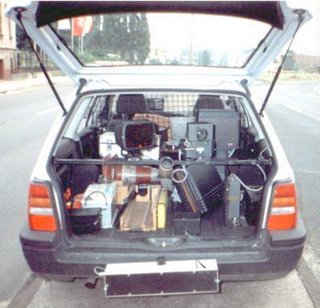RadarTest
Author Craig Peterson of Radartest.com weighs in on topics for the enthusiast driver including radar detectors, photo-enforcement, mobile electronics and vehicles.
Tuesday, May 16, 2006
Scottsdale's Speed-Camera Scam
 Since early 2004 I’ve been researching automated enforcement in metro Phoenix, especially Scottsdale. That wealthy suburb has been the most aggressive in the country in finding new applications for red light cameras. They make heavy use of photo radar vans as well. And they were the first to install cameras in a mid-block location where there’s no traffic light, just plenty of targets rolling past. This year they installed six cameras on heavily traveled Loop 101, also a first.
Since early 2004 I’ve been researching automated enforcement in metro Phoenix, especially Scottsdale. That wealthy suburb has been the most aggressive in the country in finding new applications for red light cameras. They make heavy use of photo radar vans as well. And they were the first to install cameras in a mid-block location where there’s no traffic light, just plenty of targets rolling past. This year they installed six cameras on heavily traveled Loop 101, also a first.After two years of doing speed surveys, intersection analysis, studying accident stats and poring over thousands of pages of documents, I’ve started working on the story. Scottsdale won’t like it.
What I’ve found is that Scottsdale:
· Never bothered to do a traffic study on Loop 101 to justify the installation of the speed cameras
· Has no idea what the fatal accident rate is on the Loop (it’s an outstandingly safe freeway)
· Developed no criteria by which to judge the effectiveness of the nine-month “trial program”
· Expects to issue 300,000 tickets during this period, grossing $47 million
· Spent over $400,000 of public funds on a publicity campaign to convince residents and the witless local press that speeding is a problem on the Loop and elsewhere
· Conducted a rigged traffic-speed survey on the Loop to support this contention
· Stonewalls investigative reporters looking for data that should be freely available under the state’s Open Records law
· Uses separate accounts to show a net loss on their automated enforcement program while concealing millions in profits
· Routinely lies to the press
· Installs red light cameras at intersections with no history of excessive accidents caused by red-light running
· Has never done a study to see if their red light cameras reduce red-light running
· Neglects to mention that most Scottsdale intersections monitored by red light cameras experience up to a 35 percent increase in accidents after cameras are installed. The remaining intersections have accident rates little different than non-camera intersections.
· Began issuing speeding tickets (called Speed On Green) with their red light cameras without bothering to mention it to the public
· Writes 600 percent more $178 speeding tickets than $157 red light tickets at intersections with cameras (some drivers get hit with both)
· Relocates their cameras to follow shifting traffic patterns. When traffic volume increased in the northeast part of town, the cameras followed. I’d call this practice “following the money.”
And Scottsdale’s not alone. Neighboring Mesa, facing a $30 million budget shortfall this year, responded by increasing their red light cameras from 13 to 30. And they added Speed on Green at every one. This was announced to the press in a two-paragraph press release that was almost totally ignored. I calculate the changes should boost their automated enforcement revenue by at least $4 million this year.
Good thing I’ll be moving from Mesa shortly after the story appears on Radartest.com.
Ku-band Rumor

Ku Band
Since January I’ve been looking into the Ku-band rumor. I’ve known of only one Ku-band radar ever to appear in the States. That was a Gatso Type 09 Microspeed unit (private labeled as a Speedophot) brought here for a three-month Federal Highway Administration photo radar test along the Washington, D.C. Beltway in 1990. The unit was returned to Europe after the test concluded. (It’s also been out of production since 1988. Judging from its size--that enormous box on the rear bumper is the antenna--is this any wonder?)
According to one Web site whose operator is known for rumor-mongering, there’s a possibility that a U.S. manufacturer may introduce a Ku-band radar. From what I’ve found, there’s an equally good possibility of an asteroid hitting Topeka later this year.
Turns out that a single U.S. radar manufacturer has cobbled up a couple of Ku-band prototypes—for their Irish distributor. And there’s a good likelihood that the unit will never be produced. The chances of its being released in the U.S.: about zero.
But it’s given Cobra Electronics a 12th “band.” There are only three radar and one lidar (laser) bands in use here, a number highly unlikely ever to increase. But twelve band’s got to be better than four, right?


